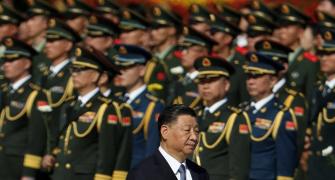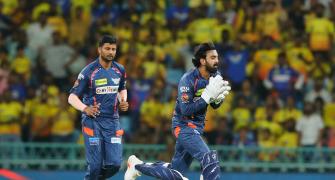One month after Mumbai's eagerly awaited media war began with the entry of two new English language dailies, the story is going around that an advertising agency professional kept a Times of India ad sales executive waiting for 30 minutes!
The story is told with relish, as for years the reverse (ad agency executives invariably waited to see TOI's response team) was true of the Mumbai market, since The Times of India from the Bennett, Coleman stable, has been a virtual monopoly in India's richest city.
With the Mumbai forays by Hindustan Times and Daily News & Analysis (DNA --promoted by the Dainik Bhaskar group and Zee), the city's advertising industry happily anticipates the increased level of competition.
"Media planners are generally thrilled as two strong publications have entered the Mumbai market almost together," says Nayan Desai, head of print media buying at Lintas.
Adds Suraj Suvarna of media buying firm Carat, "Competition is welcome. We would be happy if a paper has even half the circulation of TOI. We're recommending DNA to clients with smaller budgets."
Lintas' Desai, however, does not buy the argument about a change of attitude at TOI. It still holds nearly 80 per cent share in Mumbai's Rs 1,500 crore (Rs 15 billion) print media market.
Besides, advertising in HT and DNA will take time to pick up in the absence of readership survey numbers. But Farokh Balsara, head of Ernst & Young's media practice, believes that "HT has done well. It has targeted Delhiites in Mumbai to sell to and is offering advertisers a Delhi-Mumbai package."
Predictably, HT and DNA's ad rates (Rs 800-840 sq cms) are almost half of TOI's. So, has the market leader softened its rate card?
On the contrary, on August 15, TOI hiked its per square cms tariff from Rs 1,200 sq cms to Rs 1,500 square cms besides making it mandatory for those buying a national package to buy its tabloid Mumbai Mirror at an additional Rs 100 per square cms.
But senior executives at media buying agencies claim that the rate increase is only on paper and TOI is offering generous "incentives" to its larger clients.
HT's circulation in Mumbai is still small though -- industry estimates suggest that HT sells between 75,000 and 100,000 copies, compared to TOI's 510,000.
Though officially DNA claims to sell 295,000, trade sources estimates vary wildly from 150,000 to 225,000 copies a day. Says Dainik Bhaskar (that's co-promoting DNA) director Girish Agarwal: "We are rocking in Mumbai." Despite several attempts to speak to them, HT Media Ltd and Bennett, Coleman executives did not offer their official comments.
Both HT and DNA are trying to capture the Mumbai market through line sales, the subscription route and news stand sales. HT offers a year-long subscription for Rs 398 which, works out to barely a rupee per copy.
Observes Lakshmi Narasimhan, director CTG, from media buying agency GroupM, "HT's is a good strategy. Readers are locked in for a year and a base circulation is ensured."
The new papers may not exactly be flying off the news stands, but pricing seems to have worked in their favour. On the stands, HT costs Rs 2.50 while DNA comes for Rs 2 compared to TOI's Rs 4 per copy (with a free copy of the group's new tabloid, Mumbai Mirror).
Executives in the DNA camp claim that TOI's news stand sale has dropped by 35,000 copies as a casual buyer prefers to pick up the Rs 2 paper.
Adds Ashish Pingle, who runs a couple of Wheeler stalls at platforms, "Readers seem to like DNA and it's not only because of the price." Says Rajesh Jain, national director, ICE, KPMG, "DNA's strategy is to push through distribution and pull the consumer through hoardings. We need to give the experiment with the vendors some time to see how it works."
The companies are battling it out on the distribution front amidst much mudslinging. Charges of buying out vendors to ensure they do not pick up rival newspapers are flying in all directions.
Both DNA and HT are offering vendors a one rupee commission. To counter this, TOI is offering Rs 1.75 since Mumbai Mirror is distributed free with the paper.
After years of depending on TOI, newspaper vendors and agents, like advertisers, find they have a choice. Some have bagged contracts from HT to sell at traffic signals while others are getting incentives from DNA to source subscriptions. Any vendor who can locate a potential subscriber gets Rs 6.
In a bid to earn more, vendors are straying from their assigned territories. They also claim that competition has softened TOI -- "it actually takes back unsold copies now". Trade sources also claim that TOI has increased its print run to make sure there is no shortage.
Media buyers believe that from a content perspective, the new papers are still evolving. HT, they say, has not shown its "political" character yet. Says Narasimhan, "It will take time for the personality of the brand to emerge, but DNA is nicely packaged. It hasn't lived up to its huge expectations though."
Sandip Tarkas, head of Media Direction, believes that "The Times of India is refreshingly different from what it was six months ago. Other than more colour and a free 48-page Mumbai Mirror thrown in, it's become more readable."
So, is Mumbai's print media market overcrowded? "Confusing -- yes. Overcrowded -- no," says Tarkas. Mumbai city consumes just 75 per cent of the English newspaper copies that Delhi does and not many households are 2-3 paper homes. "I think the Mumbai print market can easily support this level and more," says Tarkas.
Points out Girish Agarwal: "If Gujarat's advertising market could grow 35 per cent after Divya Bhaskar's entry, Mumbai must grow at least that much if not more." Adds Jain: "The operating market will expand because customers will demand better products."
And, therefore, more players will be attracted to the market. Unlike in the past, when newspapers failed to take off, this time round the players have deeper pockets.
But is there a clear winner in round one of Mumbai's media war? "You can't predict the outcome of a one day match after the first over," says Tarkas. However, first round shows that TOI is a very strong brand in Mumbai -- "a fact we knew already", he adds.
But as advertising in the new papers trickles in, TOI will have to run hard to retain its numero uno position. The verdict then is that the winner, so far, is the consumer.







